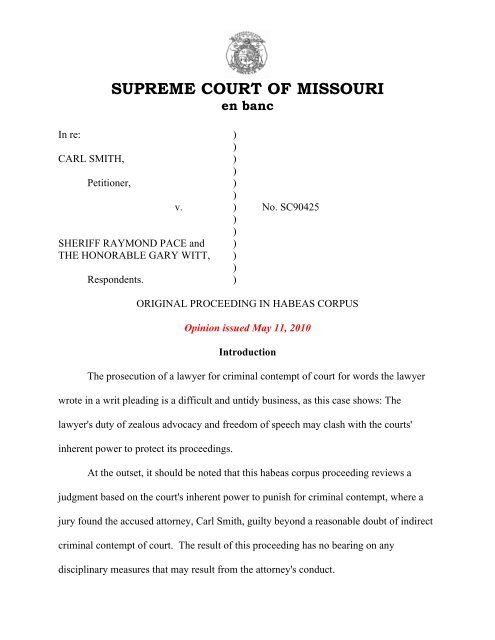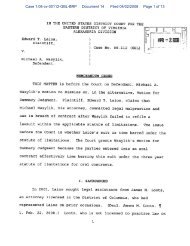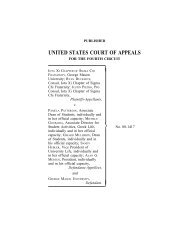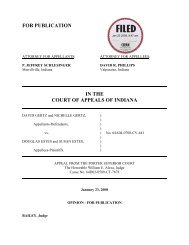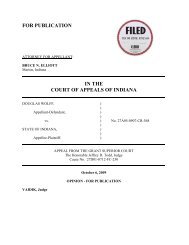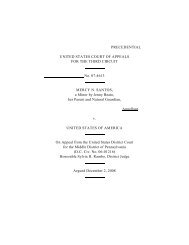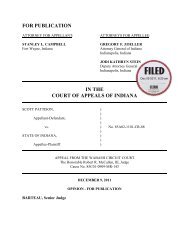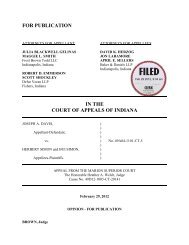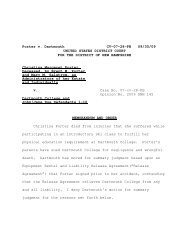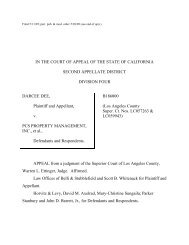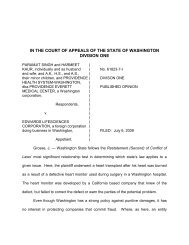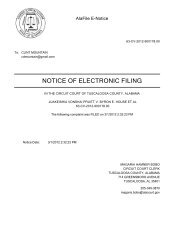SUPREME COURT OF MISSOURI - Lawyers USA Online
SUPREME COURT OF MISSOURI - Lawyers USA Online
SUPREME COURT OF MISSOURI - Lawyers USA Online
You also want an ePaper? Increase the reach of your titles
YUMPU automatically turns print PDFs into web optimized ePapers that Google loves.
<strong>SUPREME</strong> <strong>COURT</strong> <strong>OF</strong> <strong>MISSOURI</strong><br />
en banc<br />
In re: )<br />
)<br />
CARL SMITH, )<br />
)<br />
Petitioner, )<br />
)<br />
v. ) No. SC90425<br />
)<br />
)<br />
SHERIFF RAYMOND PACE and )<br />
THE HONORABLE GARY WITT, )<br />
)<br />
Respondents. )<br />
ORIGINAL PROCEEDING IN HABEAS CORPUS<br />
Opinion issued May 11, 2010<br />
Introduction<br />
The prosecution of a lawyer for criminal contempt of court for words the lawyer<br />
wrote in a writ pleading is a difficult and untidy business, as this case shows: The<br />
lawyer's duty of zealous advocacy and freedom of speech may clash with the courts'<br />
inherent power to protect its proceedings.<br />
At the outset, it should be noted that this habeas corpus proceeding reviews a<br />
judgment based on the court's inherent power to punish for criminal contempt, where a<br />
jury found the accused attorney, Carl Smith, guilty beyond a reasonable doubt of indirect<br />
criminal contempt of court. The result of this proceeding has no bearing on any<br />
disciplinary measures that may result from the attorney's conduct.
Smith was prosecuted for criminal contempt of court for strong words he used in<br />
petitioning the court of appeals for a writ seeking to quash a subpoena issued for a grand<br />
jury in Douglas County. Referring to the prosecuting attorney and the judge overseeing<br />
the grand jury, Smith wrote: "Their participating in the convening, overseeing, and<br />
handling the [sic] proceedings of this grand jury are, in the least, an appearance of<br />
impropriety and, at most, a conspiracy by these officers of the court to threaten, instill<br />
fear and imprison innocent persons to cover-up and chill public awareness of their own<br />
apparent misconduct using the power of their positions to do so."<br />
Strong words, indeed. Smith says his words are protected by the First<br />
Amendment. The state, on behalf of the respondent judge and sheriff, says they are not.<br />
The jury was instructed to determine – in the curious language of earlier Missouri<br />
cases – whether Smith's "statements degraded and made impotent the authority of [the<br />
court] and impeded and embarrassed the administration of justice." See State ex rel.<br />
Chassaing v. Mummert, 887 S.W.2d 573, 578 (Mo. banc 1994). The jury found Smith<br />
guilty of criminal contempt. Following the verdict, the court entered an order of<br />
commitment for criminal contempt sending Smith to jail for 120 days. Smith petitioned<br />
for a writ of habeas corpus, challenging the lawfulness of his conviction and<br />
incarceration. This Court issued a writ of habeas corpus and stayed the remainder of<br />
Smith's jail commitment pending the outcome of this writ proceeding.<br />
Facts and Procedural History<br />
Smith, the petitioner in this habeas case, appeared in March 2008 before Judge R.<br />
Craig Carter of Douglas County, who had been assigned to oversee the conduct of a
Douglas County grand jury that just had been convened. On behalf of one of his clients<br />
and Smith's secretary, Smith filed a motion to quash the subpoena and a motion for<br />
continuance. 1 Judge Carter overruled Smith's motion to quash but gave him seven days<br />
to file a writ in the court of appeals challenging the judge's decision. Smith then filed<br />
such a petition.<br />
On the basis of two paragraphs of Smith's petition filed in the court of appeals,<br />
Judge Carter cited Smith for criminal contempt. The two paragraphs of Smith's writ<br />
petition said:<br />
1. The attached exhibits reflect the personal interest, bias and purported<br />
criminal conduct of Respondent [Judge Carter], Prosecuting Attorney<br />
Christopher Wade, and others [sic] members in the judicial system in the<br />
Forty-Fourth Judicial Circuit. Their participating in the convening,<br />
overseeing, and handling the [sic] proceedings of this grand jury are, in the<br />
least, an appearance of impropriety and, at most, a conspiracy by these<br />
officers of the court to threaten, instill fear and imprison innocent persons<br />
to cover-up and chill public awareness of their own apparent misconduct<br />
using the power of their positions to do so.<br />
2. When Relators [Smith's client and Smith's secretary] on March 31, 2008<br />
asked Respondent [Judge Carter] and the prosecuting attorney who were<br />
the targets of this grand jury, Relators' assertion that the targets were<br />
Relators and their counsel [Smith] was met with tacit admission of silence.<br />
This grand jury, as in the last grand jury in Douglas County, is being used<br />
by those in power in the judicial system as a covert tool to threaten,<br />
intimidate and silence any opposition to their personal control-not the<br />
laudable common law and statutory purposes for which the grand jury<br />
system was created.<br />
1 Smith contended that production of the documents requested pursuant to the grand<br />
jury's subpoena was improper for a variety of reasons. He also suggested that the<br />
handwriting on the subpoena was not the prosecuting attorney's and that the grand jury<br />
had been called in retribution for his client's filing of a motion to disqualify the<br />
prosecuting attorney in a pending criminal case.<br />
3
Smith's "attached exhibits" included affidavits, deposition transcripts, letters and court<br />
filings in which Smith and others made allegations against Douglas County prosecuting<br />
attorney Christopher Wade and the presiding circuit judge of the 44th Judicial Circuit,<br />
claiming that these officials had committed criminal offenses and that the attorney<br />
general and members of his staff and other attorneys practicing in the 44th Judicial<br />
Circuit had acted unlawfully. The two paragraphs quoted here name only Judge Carter<br />
and the prosecutor.<br />
Following receipt of a copy of Smith's court of appeals writ petition in April 2008,<br />
Judge Carter issued an order of contempt setting forth the above-referenced paragraphs<br />
from Smith's writ petition. 2 Thereafter, Judge Gary Witt, respondent here, was assigned<br />
to preside over Smith's jury trial for criminal contempt.<br />
The state presented the two paragraphs cited in Judge Carter's order as well as<br />
testimony from Judge Carter in which he testified that the facts in the two paragraphs are<br />
false. Judge Carter also testified that he did not believe the two paragraphs were proper<br />
"argument" and that a writ petition was an improper avenue for an attorney who believes<br />
2 Judge Carter's order also said:<br />
Mr. Smith's Petition continues on to defame the elected Douglas<br />
County Prosecuting Attorney, several members of the local bar, and even<br />
goes so far as to question actions of the Office of the Chief Disciplinary<br />
Counsel's actions [sic]. Additionally, the affidavits and exhibits attached to<br />
Mr. Smith's Petition are the most scurrilous, defamatory, venomous attack<br />
on the Judicial System the Court has ever witnessed. Indeed, Mr. Smith's<br />
writing "tends to degrade or make impotent the authority of the court or to<br />
impede or embarrass the administration of justice." Curtis v. Tozer, 374<br />
S.W.2d 557, 568 (Mo. App. 1964).<br />
However, the state chose not to pursue any action on this part of his order.<br />
4
a judge has committed, or is committing, wrongdoing. 3 Judge Carter stated the proper<br />
avenue was for Smith to file a complaint with the Commission on Retirement, Removal<br />
and Discipline. Prior to trial, respondent Judge Witt noted in a docket entry that<br />
"[p]laintiff [the state] stipulates that the actions of the defendant [Smith] did not interfere<br />
w/grand [sic] jury and that Judge Carter did not rule differently, or fail to take any action<br />
with regard to the grand jury based on actions of defendant ...." The jury received this<br />
portion of the docket entry as evidence.<br />
Although Smith objected to the state's proposed verdict-directing instruction on<br />
the grounds that it failed to list the essential elements of criminal contempt, either as a<br />
statutory crime or a contempt citation by a judge as at common law, 4 the trial court gave<br />
the state's proposed verdict-directing instruction:<br />
If you find and believe from the evidence beyond a reasonable<br />
doubt:<br />
First, that on or about April 3, 2008, in the County of Douglas, State<br />
of Missouri, the defendant served upon R. Craig Carter a<br />
Petition for Writ of Prohibition against R. Craig Carter, and<br />
Second, that R. Craig Carter was the Judge of the Circuit Court of<br />
Douglas County, Associate Circuit Division, Forty-fourth<br />
Judicial Circuit, and<br />
Third, that in his Petition for Writ of Prohibition the defendant stated<br />
that R. Craig Carter in his position as Judge, used a grand jury<br />
to threaten, install fear and imprison innocent persons to<br />
3 Despite the interchangeable use in common parlance of the words "attorney" and<br />
"lawyer," it is technically precise to use the word "lawyer" to denote a person who is a<br />
member of the legal profession (the occupation) and "attorney" as one who represents the<br />
interests of a client (the role). See definitions in WEBSTER'S NEW THIRD INTERNATIONAL<br />
DICTIONARY (1993).<br />
4 See State ex inf. Crow v. Shepherd, 76 S.W. 79 (Mo. 1903), for a discussion of<br />
contempt at common law. See also State ex rel. Pulitzer Pub. Co. v. Coleman, 152 S.W.<br />
2d 640, 646 (Mo. banc 1941); State ex rel. Burrell-El v. Autrey, 752 S.W.2d 895 (Mo.<br />
App. 1988); and Mechanic v. Gruensfelder, 461 S.W.2d 298 (Mo. App. 1970).<br />
5
cover-up and chill public awareness of apparent misconduct<br />
using the power of his position to do so, and<br />
Fourth, that in his Petition for Writ of Prohibition the defendant<br />
stated that R. Craig Carter in his position as Judge, handled a<br />
grand jury as a tool to threaten, intimidate and silence any<br />
opposition to his personal control, and<br />
Fifth, the defendant's statements degraded and made impotent the<br />
authority of the Circuit Court of Douglas County, Associate<br />
Circuit Division and impeded and embarrassed the<br />
administration of justice,<br />
then you will find the defendant guilty of contempt of court.<br />
However, unless you find and believe from the evidence beyond a<br />
reasonable doubt each and all of these propositions, you must find the<br />
defendant not guilty of contempt of court.<br />
The jury found Smith guilty of criminal contempt based on this instruction. After<br />
hearing evidence on sentencing in September 2009, the respondent judge committed<br />
Smith to 120 days in jail. 5 Smith then sought a writ of habeas corpus. This Court issued<br />
a stay in October 2009 directing Sheriff Raymond Pace, respondent, to release Smith<br />
pending review by this Court as provided in Rule 91.<br />
Standard of Review<br />
There is no right of appeal from a judgment of criminal contempt. Ex parte Clark,<br />
106 S.W. 990, 997 (Mo. banc 1907). The only remedy available is to file a writ of<br />
habeas corpus. Id.; Rule 91.01(b) (A person may seek a writ of habeas corpus when the<br />
person is "restrained of liberty within this state [in order] to inquire into the cause of such<br />
restraint.").<br />
5 Smith initially was sentenced to confinement in the Douglas County jail, but he<br />
immediately was transferred to the Ozark County jail. Sheriff Raymond Pace,<br />
respondent, is the sheriff of Ozark County.<br />
6
When this Court issues a writ of habeas corpus, as the Court did in November<br />
2009, the petitioner, Smith, is permitted to brief and argue his grounds for relief so that<br />
the court may "inquire into the cause of [petitioner's] restraint," Rule 91.01(b), and<br />
determine whether a release from custody is warranted. State ex rel. Zinna v. Steele, 301<br />
S.W.3d 510, 513 (Mo. banc 2010). The decision whether to grant relief is "limited to<br />
determining the facial validity of confinement, which is based on the record of the<br />
proceeding that resulted in the confinement." State ex rel. Nixon v. Jaynes, 63 S.W.3d<br />
210, 214 (Mo. banc 2001). The habeas court may grant relief by ordering the petitioner<br />
discharged from unlawful restraint or deny relief by permitting the petitioner to remain in<br />
custody. Rule 91.18; Rule 91.20; Zinna, 301 S.W.3d at 513.<br />
Missouri courts have both an inherent power under the constitution to punish for<br />
contempt as well as authority to try contempt-of-court cases under the statutory crime of<br />
contempt, section 476.110, RSMo 2000. 6 Osborne v. Purdome, 244 S.W.2d 1005, 1012<br />
(Mo. banc 1952).<br />
6 Section 476.110 provides:<br />
Every court of record shall have power to punish as for criminal<br />
contempt persons guilty of:<br />
(1) Disorderly, contemptuous or insolent behavior committed during its<br />
session, in its immediate view and presence, and directly tending to<br />
interrupt its proceeding or to impair the respect due to its authority;<br />
(2) Any breach of the peace, noise or other disturbance directly tending<br />
to interrupt its proceedings;<br />
(3) Willful disobedience of any process or order lawfully issued or made<br />
by it;<br />
(4) Resistance willfully offered by any person to the lawful order or<br />
process of the court;<br />
7
Missouri's contempt statute, section 476.110, provides for a finding of contempt<br />
only where the actions being punished are committed in the court's presence, the actions<br />
actually interrupt the court's proceedings or a person disobeys an order of the court. The<br />
contempt statute, however, does not limit the power of the courts to punish for contempt<br />
as at common law. 7 Osborne, 244 S.W.2d at 1012 ("It is settled law that every<br />
constitutional court of common-law jurisdiction has the inherent power to punish for<br />
contempt, and cannot be shorn of such power by statute."). 8 The courts' inherent power<br />
includes "those incidental powers [that] are necessary and proper to [ensure] the<br />
performance" of the courts' judicial function under the constitution – "the trying and<br />
determining of cases in controversy." Coleman, 152 S.W.2d at 646. "The power to<br />
punish for contempt should be used sparingly, wisely, temperately and with judicial self-<br />
restraint." In re Estate of Dothage, 727 S.W.2d 925, 928 (Mo. App. 1987).<br />
"[T]here are two classes of contempt – civil and criminal, each class having two<br />
subcategories – direct and indirect." Chassaing, 887 S.W.2d at 578. Criminal and civil<br />
contempt are distinguished by the content of the judgment. Id. "Criminal contempt is<br />
punitive in nature and acts to protect, preserve, and vindicate the authority and dignity of<br />
(5) The contumacious and unlawful refusal of any person to be sworn as<br />
a witness, or, when so sworn, to refuse to answer any legal and proper<br />
interrogatory.<br />
7 The respondent judge here argues the contempt was sought under Rule 36.01(b).<br />
However, a rule, such as Rule 36.01(b), does not provide the right to seek a cause of<br />
action, but merely the procedure to do so. The court's inherent power, not the rule, is the<br />
source of the court's power to punish for contempt.<br />
8 Although the legislature has chosen to specify five acts as contemptuous, a court could<br />
choose to find these acts contemptuous under its inherent powers as well. The courts'<br />
inherent powers are neither expanded nor infringed upon by the statutory contempt<br />
power. See Osborne, 244 S.W.2d at 1012.<br />
8
the judicial system and to deter future defiance." Id. Civil contempt is intended to<br />
benefit a party for whom relief has been granted by coercing compliance with the relief<br />
granted. Id. In this case, Judge Carter sought to punish Smith by criminal contempt for<br />
the language he had used in his writ petition.<br />
"A direct contempt occurs in the immediate presence of the court or so near as to<br />
interrupt its proceedings." Id. The judge may punish a direct contempt summarily if the<br />
judge saw the conduct constituting contempt. Id.; Rule 36.01(a). However, an indirect,<br />
or "constructive," contempt "arises from an act outside the court that tends to degrade or<br />
make impotent the authority of the court or to impede or embarrass the administration of<br />
justice." Chassaing, 887 S.W.2d at 578. Acts of indirect contempt require that the<br />
defendant be given notice and a hearing as set out in Rule 36.01(b). Id. at 379. In this<br />
case, the criminal contempt alleged was indirect.<br />
Analysis<br />
Criminal Contempt and "Degrading" Speech<br />
Despite its origins deep in the common law, the elements of criminal contempt are<br />
not well developed. Reported cases of jury trials are hard to find; only in relatively<br />
recent years has the United States Supreme Court held that persons cited for contempt<br />
where "serious punishment" is sought must be afforded the right of trial by jury. Bloom<br />
v. Illinois, 391 U.S. 194 (1968). 9 For purposes of determining whether the constitution<br />
9 This Court has held that at common law there was no right to trial by jury for contempt.<br />
Pulitzer Pub. Co., 152 S.W.2d at 645-46. But cf. Earl C. Dudley, Jr., Getting Beyond the<br />
Civil/Criminal Distinction: A New Approach to the Regulation of Indirect Contempts, 79<br />
VA. L. REV. 1025, 1939 n. 14 (1993) ("From the 14th century onward, English common<br />
9
equires a right to a jury trial, "serious punishment" means incarceration in excess of six<br />
months. Lewis v. United States, 518 U.S. 322, 325-26 (1996). Criminal contempt<br />
proceedings with no incarceration or incarceration of fewer than six months are<br />
considered "petty crimes," and no right to jury trial exists. Id. In criminal contempt<br />
cases where there is no specified maximum punishment, 10 courts may use the penalty<br />
actually imposed to determine the character of the offense and whether the right to jury<br />
trial existed. Bloom, 391 U.S. at 211. Examining whether there is a right to a jury after<br />
the case is tried, however, seems awkward; a trial court needs to know before trial<br />
whether a jury is needed. 11 The answer is that if the prosecution seeks a commitment<br />
exceeding six months, a jury constitutionally is required – regardless of the penalty<br />
actually imposed after trial. See Right to Jury Trial–Under Particular Circumstances, 7A<br />
FED. PROC., L. ED. sec. 17:17 (2010) (citing cases). If a court conducts a contempt<br />
hearing without a jury, Bloom limits the incarceration time to six months. Id.<br />
law distinguished between contempts committed in facie curiae and those committed<br />
outside the presence of the court. Prior to the 18th century, out-of-court contempts by<br />
nonparties to litigation were generally treated as ordinary criminal offenses and tried<br />
before juries. Contempts in facie curiae and out-of-court contempts by parties (generally<br />
disobedience to court orders) were apparently dealt with by summary procedures, or at<br />
least without the intervention of juries. By the late 18th century, all contempts were dealt<br />
with by summary procedures at common law.") (internal citations omitted). These<br />
precedents must give way to the United States Supreme Court's 1968 decision in Bloom,<br />
discussed above in the text, which held that where a serious penalty is imposed, such as<br />
more than six months imprisonment, an alleged contemnor is guaranteed the right to trial<br />
by jury under the Sixth Amendment. 391 U.S. 194.<br />
10 In Missouri, "[p]unishment for contempt may be by fine or imprisonment ... in the<br />
discretion of the court." Section 476.120, RSMo 2000.<br />
11 The question here is similar to the question of a court's need to know whether the state<br />
seeks incarceration to determine whether the court must appoint counsel for an indigent<br />
defendant. See State ex rel. Missouri Pub. Defender Comm'n v. Pratte, 298 S.W.3d 870,<br />
887 (Mo. banc 2009).<br />
10
The First Amendment has been held to trump restrictions on lawyers' speech.<br />
Gentile v. State, 501 U.S. 1030 (1991). This Court does not accept the proposition that<br />
First Amendment rights bar punishment of contemptuous speech, 12 but does recognize<br />
12 See, e.g., Shepherd, 76 S.W. at 79-80. The Court in Shepherd found a newspaper<br />
publisher in contempt of court for publishing harsh criticism of this Court, which harkens<br />
to the olden days when judges of this Court were elected in partisan elections. The<br />
newspaper, published in Warrensburg, said:<br />
When a citizen of Missouri stops long enough to think of the condition of<br />
affairs in his state, it is enough to chill his blood.... [T]he Supreme Court<br />
has, at the whipcrack of the Missouri Pacific Railroad, sold its soul to the<br />
corporations, and allowed Rube Oglesby to drag his wrecked frame through<br />
this life without even the pitiful remuneration of a few paltry dollars.<br />
Learned men of the law say that Rube Oglesby had the best damage suit<br />
against a corporation ever taken to the Supreme Court. This very tribunal,<br />
after reading the evidence and hearing the arguments of the attorneys,<br />
rendered a decision sustaining the judgment of the lower court, which<br />
decision was concurred in by six of the seven members of the court. This is<br />
usually the end of such cases, and the decision of a Supreme Court, once<br />
made, usually stands. But not so in the Oglesby case. Three times was this<br />
case, at the request of the railway attorneys, opened for rehearing, and three<br />
times was the judgment of the lower court sustained. But during this time,<br />
which extended over a period of several years, the legal department of this<br />
great corporation was not the only department which was busy in<br />
circumventing the defeat of the Oglesby case. The political department was<br />
very, very busy. Each election has seen the hoisting of a railway attorney to<br />
the Supreme Bench, and, when that body was to the satisfaction of the<br />
Missouri Pacific, the onslaught to kill the Oglesby case began. A motion for<br />
a rehearing was granted, and at the hearing of the case it was reversed on an<br />
error in record of the trial court, and was sent back for retrial. That was in<br />
the early part of the year 1902. The case was tried in Sedalia before Circuit<br />
Judge Longan, one of the ablest jurists in the state, and we have been<br />
informed that no error was allowed to creep into the record at the second<br />
trial. Again the jury rendered judgment in favor of Oglesby for $15,000,<br />
and again the case was appealed to the Supreme Court. An election was<br />
coming on, and the railroad needed yet another man to beat the Oglesby<br />
case. The Democratic nominating convention was kind, and furnished him,<br />
in the person of Fox. The railroad, backed by four judges on the bench,<br />
allowed the case to come up for final hearing, and Monday the decision was<br />
handed down, reversed and not remanded for retrial. The victory of the<br />
11
that the values and limits of the constitutional right must inform the development of the<br />
elements of criminal contempt. This is especially true of cases of indirect contempt,<br />
which do not take place in the court's presence.<br />
The state, on behalf of the respondents Judge Witt and Sheriff Pace, argues that it<br />
is sufficient to sustain Smith's conviction for contempt because a jury found that Smith's<br />
"statements degraded and made impotent the authority of the Circuit Court of Douglas<br />
County, Associate Circuit Division and impeded and embarrassed the administration of<br />
justice." Smith argues that his statements are protected by the First Amendment to the<br />
United States Constitution and, therefore, a judgment of contempt for these statements is<br />
improper. The parties cite no Missouri reported case, nor can the Court find one, where a<br />
contempt-of-court charge was tried to a jury. In fairness to the parties, the law of indirect<br />
railroad has been complete, and the corruption of the Supreme Court has<br />
been thorough. It has reversed and stultified itself in this case until no sane<br />
man can have any other opinion but that the judges who concurred in the<br />
opinion dismissing the Oglesby case have been bought in the interest of the<br />
railroad. What hope have the ordinary citizens of Missouri for justice and<br />
equitable laws in bodies where such open venality is practiced? And how<br />
long will they stand it? The corporations have long owned the Legislature,<br />
now they own the Supreme Court, and the citizen who applies to either for<br />
justice against the corporation gets nothing. Rube Oglesby and his attorney,<br />
Mr. O. L. Houts, have made a strong fight for justice. They have not got it.<br />
The quivering limb that Rube left beneath the rotton [sic] freight car on<br />
Independence Hill, and his blood that stained the right of way of the<br />
soulless corporation, have been buried beneath the wise legal verbiage of a<br />
venal court, and the wheels of the Juggernaut will continue to grind out<br />
men's lives, and a crooked court will continue to refuse them and their<br />
relatives damages, until the time comes when Missourians, irrespective of<br />
politics, rise up in their might and slay at the ballot box the corporationbought<br />
lawmakers of the state.<br />
Id. The Court's ability to punish by contempt for such language in the current era<br />
would be constrained by the First Amendment.<br />
12
contempt as applied to lawyers is confusing and unclear both in this state and throughout<br />
the nation. 13<br />
Criticism by non-lawyers<br />
Comments regarding pending court cases – when made by non-lawyers – are<br />
protected by the First Amendment. In Bridges v. California, the United States Supreme<br />
Court established that the First Amendment requires there to be "a clear and present<br />
danger" of a substantive evil before newspaper publishers can be charged with contempt<br />
for publishing criticism of a judge regarding a pending case. 314 U.S. 252, 263 (1941).<br />
Moreover, the evil itself must be "extremely serious" and the imminence of danger<br />
"extremely high before utterances can be punished." Id. In holding the publishers could<br />
not be charged with contempt, the Supreme Court said it was not enough for the<br />
published statements to have either an "inherent tendency" or a "reasonable tendency" to<br />
affect the administration of justice. Id. at 273.<br />
Following Bridges, the Supreme Court examined what protection should be given<br />
to comments in a newspaper that directly criticized a specific judge. Craig v. Haney, 331<br />
U.S. 367 (1947). The Supreme Court first noted its earlier holding that although<br />
'"[c]ourts must have power to protect the interests of ... litigants before them from<br />
unseemly efforts to pervert judicial action. In the borderline instances where it is difficult<br />
13 See, e.g., Louis S. Raveson, Advocacy and Contempt: Constitutional Limitations on the<br />
Judicial Contempt Power, Part One: The Conflict Between Advocacy and Contempt, 65<br />
WASH L. REV. 477, 482 (1990) ("Presently, the standards governing both the limits of<br />
acceptable advocacy and the scope of the contempt power are haphazard and<br />
imprecise."); Dudley, Getting Beyond the Civil/Criminal Distinction, at 1025 ("The<br />
literature on contempt of court is unanimous on one point: the law is a mess.").<br />
13
to say upon which side the alleged offense falls, we think the specific freedom of public<br />
comment should weigh heavily against a possible tendency to influence pending cases.'"<br />
Id. at 373 (quoting Pennekamp v. Florida, 328 U.S. 331, 347 (1946)). The Supreme<br />
Court then examined the specific language the newspaper had used to criticize the<br />
judge. 14 See Haney, 331 U.S. at 375-76. The Supreme Court stated that the editorial<br />
contained "strong language, intemperate language, and [was], we assume, an unfair<br />
criticism." Id. at 376. Nevertheless, the Court reasoned that:<br />
a judge may not hold in contempt one "who ventures to publish anything<br />
that tends to make him unpopular or to belittle him ...." The vehemence of<br />
the language used is not alone the measure of the power to punish for<br />
contempt. The fires which it kindles must constitute an imminent, not<br />
merely a likely, threat to the administration of justice. The danger must not<br />
be remote or even probable; it must immediately imperil.<br />
Id. at 376 (quoting Craig v. Hecht, 263 U.S. 255, 281 (1923) (Holmes, J., dissenting))<br />
(omission in original). The Supreme Court held that although the editorial's language<br />
may lower the judge's standing in the eyes of the public, it did not "create an imminent<br />
14 According to the Court, the offensive language in the editorial was as follows:<br />
It called the judge's refusal to hear both sides "high handed," a "travesty of<br />
justice," and the reason that public opinion was "outraged." It said that his<br />
ruling properly "brought down the wrath of public opinion upon his head"<br />
since a service man "seems to be getting a raw deal." The fact that there<br />
was no appeal from his decision to a "judge who is familiar with proper<br />
procedure and able to interpret and weigh motions and arguments by<br />
opposing counsel and to make his decisions accordingly" was a "tragedy."<br />
It deplored the fact that the judge was a "layman" and not a "competent<br />
attorney." It concluded that the "first rule of justice" was to give both sides<br />
an opportunity to be heard and when that rule was "repudiated," there was<br />
"no way of knowing whether justice was done."<br />
Haney, 331 U.S. at 375-76.<br />
14
and serious threat to the ability of the court to give fair consideration to the motion for<br />
rehearing" at issue. Haney, 331 U.S. at 377-78.<br />
The Missouri appeals court applied the Supreme Court's standard in McMilian v.<br />
Rennau, in which McMilian was charged with indirect criminal contempt for his<br />
statements about a judge regarding a pending case. 619 S.W.2d 848, 850 (Mo. App.<br />
1981). McMilian had telephoned the court and asked to speak to Judge Gant about<br />
criminal charges that were pending involving McMilian's son. Id. When the bailiff<br />
informed him that the judge would not engage in ex parte discussions regarding a<br />
pending case, McMilian told the bailiff: "'Tell Judge Gant that all judges are full of sh*t<br />
and tell Judge Gant to stick it up his f**king *ss.'" Id. The court echoed the Supreme<br />
Court's decisions and held that a contempt conviction requires "a demonstrated<br />
impediment to the judicial process, real, threatened and imminent." Id. at 853. The court<br />
noted that although McMilian's remarks were "offensive and boorish, [they] were far less<br />
egregious than the widely published statements in Bridges, Pennekamp and other cited<br />
cases." Id.<br />
These cases make it clear that statements about pending cases by non-lawyers are<br />
protected by the First Amendment under a "clear and present danger" standard.<br />
Criticism by lawyers<br />
With respect to lawyers, however, it is not nearly as clear what protection the First<br />
Amendment provides. The United States Supreme Court held that states may use a lesser<br />
standard than that applied to non-lawyers to decide if a lawyer should be disciplined for<br />
his or her speech. Gentile, 501 U.S. 1030. Gentile, a Nevada attorney, held a news<br />
15
conference upon the indictment of one of his clients and allegedly violated a Nevada<br />
Supreme Court rule prohibiting attorneys from making extrajudicial statements that had a<br />
"substantial likelihood of materially prejudicing an adjudicative proceeding." Id. at 1033.<br />
Although the Supreme Court struck down the Nevada rule on other grounds, the Court<br />
endorsed Nevada's "substantial likelihood" standard as sufficient under the First<br />
Amendment for the discipline of attorneys who had made extrajudicial statements<br />
concerning pending cases. Id. at 1048-49, 1072.<br />
Since Gentile, numerous state courts have considered the regulation of lawyer<br />
speech. Almost all of these cases, however, have involved situations in which a lawyer is<br />
disciplined under his or her state's ethics rules. See, e.g., In re Comfort, 159 P.3d 1011<br />
(Kan. 2007) (citing cases). In In re Westfall, decided shortly before Gentile, this Court<br />
held that a lawyer who made a derogatory statement about a judge could be disciplined if<br />
he made the statement "with knowledge of its falsity or in reckless disregard" for the<br />
truth. 808 S.W.2d 829, 837 (Mo. banc 1991). The Court reasoned that lawyers who were<br />
subjected to discipline for their speech could be held to a higher standard than those who<br />
were subject to "civil or criminal sanctions" because lawyers were admitted to the bar "to<br />
protect the public and the administration of justice." Id. This Court distinguished<br />
Garrison v. Louisiana, which held that a district attorney who had been charged with<br />
defamation for disparaging the judicial conduct of eight judges could "be the subject of<br />
either civil or criminal sanctions" only if the statements were made "with [a] high degree<br />
of awareness of their probable falsity." 379 U.S. 64, 74 (1964). The scrutiny of a state's<br />
interest in regulating lawyer speech may be significantly higher today than when this<br />
16
Court decided Westfall. 15 See, e.g., Republican Party of Minnesota v. White, 536 U.S.<br />
765 (2002).<br />
In any event, cases involving lawyers' statements require some knowledge of<br />
falsity or, at the very least, a reckless disregard for whether the false statement was true<br />
or false. The disciplinary process may be a more suitable forum than a contempt<br />
proceeding for ascertaining a lawyer's knowledge as to the truth or falsity of the lawyer's<br />
statements. 16 Monetary sanctions pursuant to Rule 55.03(c) rather than incarceration also<br />
may be more suitable. 17<br />
The Truth May Set Him Free; Falsehoods May Get Him Jail<br />
There can be no doubt that the First Amendment protects truthful statements made<br />
in judicial proceedings. It is essential, therefore, to prove that the lawyer's statements<br />
were false and that he either knew the statements were false or that he acted with reckless<br />
disregard of whether these statements were true or false. In this case, there was no<br />
15 Geoffrey C. Hazard, Jr. & W. William Hodes commented about the contrast between<br />
Westfall and the United States Supreme Court decision In re Snyder, 472 U.S. 634<br />
(1985): "[T]he case of In re Westfall ... is troubling indeed.... [T]he Westfall court did<br />
not conscientiously assess the reasonableness of the lawyer's state of mind in making his<br />
statements, but appeared to be judging the reasonableness of what was said. Moreover,<br />
the court's findings as to the 'falseness' of what was said were themselves highly<br />
questionable." THE LAW <strong>OF</strong> LAWYERING 63-14, 63-18 (3d. ed. Supp. 2009) (emphasis in<br />
original).<br />
16 See In re Snyder, 472 U.S. at 646-47, in which the United States Supreme Court held<br />
that a lawyer's letter criticizing the Eighth Circuit court of appeals' administration of the<br />
Criminal Justice Act was not sufficient to suspend the lawyer from the practice of law,<br />
because his concerns had "merit" and "a single incident of rudeness or lack of<br />
professional courtesy-in this context-does not support a finding of contemptuous or<br />
contumacious conduct ...."<br />
17 Rule 55.03(c) applies to civil proceedings. The alleged contemptuous statements in<br />
this case were made in writ proceedings, which are civil proceedings.<br />
17
mental state (mens rea) requirement in the jury instruction. 18 The instruction did not<br />
require the jury to find that Smith knew his statements were false or that Smith showed<br />
reckless disregard for the truth. The only contested issue the instruction asked the jury to<br />
find was whether Smith's written statements to the court of appeals "degraded and made<br />
impotent the authority of the Circuit Court of Douglas County, Associate Circuit Division<br />
and impeded and embarrassed the administration of justice." Although this language is<br />
present in the scant case law available – as a sole basis for a finding of criminal contempt<br />
and the resulting order of commitment to incarceration – it does not comport with the<br />
constitutional protections of free speech in United States Supreme Court precedents.<br />
Under this instruction, the assistant attorney general prosecuting the case was able<br />
to argue, in effect, that it did not matter whether Smith's statements about Judge Carter<br />
were true or false or whether Smith thought they were true or false. The attorney told the<br />
jury that if Smith thought Judge Carter was a crook, the "legal thing" to do is to file a<br />
complaint with the disciplinary authorities. "… [Y]ou can't call the judge a crook. I ask<br />
you to read these instructions carefully and ask you to find Carl Smith guilty for<br />
contempt of court."<br />
Even in disciplinary cases, this Court and the United States Supreme Court have<br />
recognized that lawyers have First Amendment rights. A lawyer's duty to the client<br />
requires that the lawyer represent the client zealously within the bounds of the law. Rule<br />
4, Preamble: A Lawyer's Responsibilities; Sprung v. Negwer Materials, Inc., 727 S.W.2d<br />
18 "A crime generally consists of two elements: the physical, wrongful deed (the actus<br />
reus) and the guilty mind that produces the act (the mens rea)." State v. Roberts, 948<br />
S.W.2d 577, 587 (Mo. banc 1997).<br />
18
883, 893 (Mo. banc 1987) (Rendlen, J., concurring). 19 Before a lawyer can be found<br />
guilty of criminal contempt for what is written in his or her pleadings, there must be some<br />
finding that the lawyer's statements were made with actual knowledge of their falsity or<br />
that the statements were in fact false and were made with reckless disregard of whether<br />
they were true or false.<br />
The only witness in this case was Judge Carter, the complainant. He testified that<br />
Smith's written statements were false. But the jury was not asked to find that Smith's<br />
statements were false, that Smith knew they were false or that he made the statements<br />
with reckless disregard of whether they were true or false. There simply was no evidence<br />
from which the jurors could find the requisite state of Smith's mind regarding the falsity<br />
of the statements, nor were they asked to do so. 20<br />
19 The bounds of the law do not permit the lawyer to make false statements with reckless<br />
disregard for their falsity, nor do the bounds of law permit a lawyer to make statements<br />
the lawyer knows to be false. Rule 4-8.2(a).<br />
20 See Holt v. Virginia, 381 U.S. 131 (1965). In Holt, attorneys were charged with<br />
contempt for the language used alleging bias in motions to change venue and for<br />
disqualification of the judge. Id. at 134-35. The Supreme Court said:<br />
[the state's] apparent contention [is] that the contempt convictions should be<br />
sustained on the ground that petitioners' charges of bias were false. The<br />
truth or falsity of these charges was not heard, the trial court choosing<br />
instead to convict and sentence petitioners for having done nothing more<br />
than making the charges. Even if failure to prove their allegations of bias<br />
could under any circumstances ever be made part of the basis of a contempt<br />
charge against petitioners, these convictions cannot rest on any such<br />
unproven assumption.<br />
Our conclusion is that these petitioners have been punished by [the<br />
state] for doing nothing more than exercising the constitutional right of an<br />
accused and his counsel in contempt cases such as this to defend against the<br />
charges made.<br />
Id. at 137-38.<br />
19
Statements That Degrade and Make Impotent the Court's Authority?<br />
With due respect to this Court's earlier description of contempt as "statements<br />
[that] degraded and made impotent the authority of the [the court] and impeded and<br />
embarrassed the administration of justice," words that degrade or make impotent or<br />
impede or embarrass, by themselves, are not enough to support a finding of criminal<br />
contempt under United States Supreme Court precedents. In a case involving direct<br />
contempt, the United States Supreme Court said: "[w]hile we appreciate the necessity for<br />
a judge to have the power to protect himself from actual obstruction in the courtroom, or<br />
even from conduct so near to the court as actually to obstruct justice, it is also essential to<br />
a fair administration of justice that lawyers be able to make honest good-faith efforts to<br />
present their clients' cases." In re McConnell, 370 U.S. 230, 236 (1962).<br />
The First Amendment requires that the threat to the court's authority must be real;<br />
the lawyer's statements and attendant conduct actually must have interfered with or posed<br />
an imminent threat of interfering with the administration of justice. See, e.g., In re<br />
Jefferson, 657 S.E.2d 830, 833 (Ga. 2008). While this is the standard in cases of direct<br />
contempt – that is, in incidents occurring in the court's presence or vicinity – there is no<br />
logical reason to have a more relaxed standard for contempt of court for written<br />
pleadings.<br />
In this case, the state stipulated that the defendant's actions did not interfere with<br />
the grand jury and "that Judge Carter did not rule differently, or fail to take any action<br />
with regard to the grand jury based on actions of defendant ...." If that is true, as the state<br />
agrees, was the threat to the court's authority real? There is no evidence that Smith's<br />
20
written statements interfered with or posed an imminent threat of interfering with the<br />
administration of justice.<br />
Conclusion<br />
In a prosecution for indirect criminal contempt of court, initiated by a judge who<br />
cites a lawyer for contempt for the lawyer's statements, the essential elements are:<br />
(1) The lawyer's statements were false;<br />
(2) The lawyer knew the statements were false or acted with reckless disregard for<br />
whether the statements were true or false;<br />
(3) The effect of the statements constituted an actual or imminent impediment or<br />
threat to the administration of justice.<br />
Limiting cases of indirect criminal contempt to those where these elements are<br />
proved will satisfy constitutional protections for lawyer speech and will help to ensure<br />
that the courts of this state will use contempt powers "sparingly, wisely, temperately and<br />
with judicial self-restraint." In re Estate of Dothage, 727 S.W.2d at 928.<br />
In addition to the deficient jury instruction and the lack of evidence as to the<br />
essential elements of indirect criminal contempt, the trial court's judgment fails to recite<br />
any findings of fact as to the three essential elements listed above. In contempt<br />
proceedings "the facts and circumstances constituting the offense, not mere legal<br />
conclusions, must be recited in both the judgment of contempt and the order of<br />
commitment." Ex parte Brown, 530 S.W.2d 228, 230 (Mo. banc 1975); see section<br />
21
476.140, RSMo 2000. Neither the judgment of contempt nor the order of commitment<br />
contained the necessary factual findings.<br />
All concur.<br />
Smith is ordered discharged.<br />
22<br />
_________________________<br />
Michael A. Wolff, Judge


